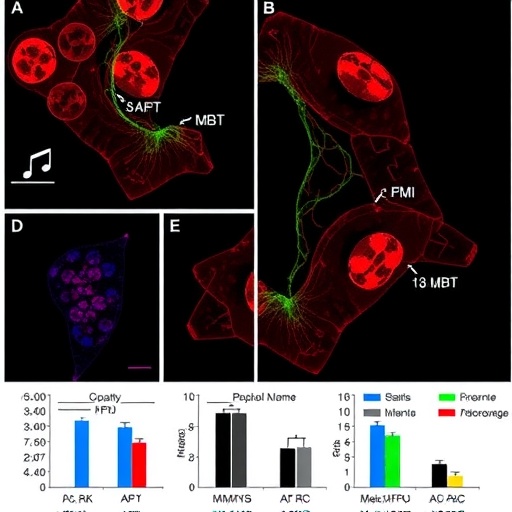Recent advancements in the field of cancer research have unveiled promising strategies in the relentless battle against tumorous growths. One such groundbreaking study is spearheaded by Jiang, Liu, He, and their collaborators, focusing on the potential of dimethyl fumarate (DMF) in redefining cervical cancer treatment through the stimulation of antitumor immunity. This innovative approach taps into an underexplored pathway—the mitochondrial DNA-cGAS-STING axis—offering new hope in the quest for more effective therapeutic interventions.
Cervical cancer remains a significant health challenge worldwide, characterized by its insidious nature and high morbidity rates. Conventional treatments such as surgery, chemotherapy, and radiotherapy focus heavily on direct tumor elimination but often fall short in enhancing the body’s immune response against malignancies. The innovative research conducted by Jiang and colleagues points towards a dual approach: directly impairing cancer cell viability while simultaneously augmenting the host’s immune defenses. The unique mechanism of DMF presents an exciting avenue for achieving these combined effects.
DMF has been widely recognized for its role in treating multiple sclerosis and psoriasis due to its anti-inflammatory properties. However, its potential utility in oncology, particularly in the context of cervical cancer, has garnered significant interest. The intriguing aspect of this study lies in how DMF can essentially ‘reprogram’ cervical cancer cells. By shifting their metabolic and immunogenic profiles, these cancer cells can be transformed into what can be described as ‘immunogenic’ targets for the innate immune response.
At the core of this research is the mitochondrial DNA (mtDNA) and its intricate interaction with the cyclic GMP-AMP synthase (cGAS) and stimulator of interferon genes (STING) pathway. Typically, the STING pathway serves as a critical mediator of the innate immune response, capable of detecting foreign DNA in the cytoplasm, leading to the activation of type I interferons and other pro-inflammatory cytokines. The study elegantly illustrates how DMF activation of the mtDNA-cGAS-STING pathway can transform the tumor microenvironment, thereby unleashing a cascade of immune responses designed to eradicate malignant cells.
The researchers meticulously demonstrated that DMF leads to an increase in mtDNA release from cervical cancer cells, which acts as a danger-associated molecular pattern (DAMP). This release triggers the cGAS-STING pathway, which enhances the expression of intrinsic immune activators. In turn, this results in the recruitment and activation of immune effector cells, such as T cells and natural killer (NK) cells, strategically aligning the immune system with the therapeutic goal of eliminating cancer cells.
One of the most compelling findings of the study is the synergistic effect of DMF in combination with immunotherapeutic agents. When used jointly with immunotherapies like immune checkpoint inhibitors, DMF significantly amplifies the overall antitumor response. This not only raises the efficacy of existing treatments but also suggests a new paradigm in how oncologists could develop combination therapies tailored for cervical cancer patients.
The potential for clinical application of DMF, as highlighted in this study, could revolutionize therapeutic strategies for cervical cancer. The ability to harness the immune system in a manner that proactively targets malignancies while simultaneously reprogramming them into more benign forms holds immense promise. It reflects a shift toward more personalized and immune-centric cancer therapies, aiming not only for short-term tumor response but for long-term immune memory against recurrences.
Furthermore, the implications of these findings extend beyond cervical cancer, potentially offering insights into tackling various malignancies where the STING pathway is underutilized or not fully leveraged. The versatility of DMF, coupled with its existing safety profile in other therapeutic areas, positions it as a strong candidate for further clinical exploration.
As the research progresses, it is crucial for the scientific community to dissect the molecular underpinnings of this immune enhancement, striving to identify biomarkers that could predict patient responses to DMF and related therapies. In addition, understanding the broader implications of mtDNA’s role in cancer immunology could pave the way for novel therapeutic strategies, igniting further inquiry into the myriad ways our cellular components interact within the immune landscape.
To conclude, the investigation by Jiang and colleagues stands as a beacon of innovation in cancer research, illuminating the potential of repurposing established drugs like DMF as powerful tools in the fight against cervical cancer. With continued exploration, it’s conceivable that the future of cancer therapy will increasingly involve the manipulation and awakening of the immune system, reprogramming how we understand and approach one of humanity’s most formidable foes.
With the relentless surge of cervical cancer cases globally, the advancements made by this team are not simply an academic triumph; they represent a transformative step toward more impactful therapeutic regimens. As researchers strive to bridge laboratory findings to clinical applications, the integration of DMF into treatment protocols could herald a new era where the ultimate goal is not just remission, but enduring immunity against cancer.
In the weeks and months to come, the scientific community will watch closely as further studies test the validity of these findings, and whether DMF can usher in a new standard of care for cervical cancer patients yearning for effective solutions against their disease.
Subject of Research: The effects of dimethyl fumarate on cervical cancer cells and its role in enhancing antitumor immunity via the mtDNA-cGAS-STING pathway.
Article Title: Dimethyl fumarate reprograms cervical cancer cells to enhance antitumor immunity by activating mtDNA-cGAS-STING pathway.
Article References:
Jiang, H., Liu, L., He, S. et al. Dimethyl fumarate reprograms cervical cancer cells to enhance antitumor immunity by activating mtDNA-cGAS-STING pathway. J Biomed Sci 32, 92 (2025). https://doi.org/10.1186/s12929-025-01187-x
Image Credits: AI Generated
DOI: https://doi.org/10.1186/s12929-025-01187-x
Keywords: cervical cancer, dimethyl fumarate, immune response, mtDNA, cGAS, STING pathway, cancer immunotherapy.




